James Maliszewski's Blog, page 88
January 2, 2023
You'll Be Amazed
January 1, 2023
Pulp Fantasy Library: Under the Thumbs of the Gods
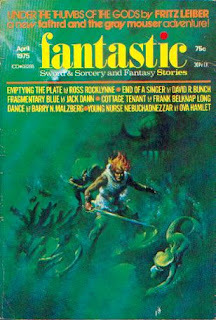 I've regularly remarked on this blog that Dungeons & Dragons (and, by extension, most fantasy roleplaying games, with a few notable exceptions) doesn't take the matter of religion very seriously. By "seriously," I mean only that very little thought seems to have been given to the nature of the gods, their relationship to mortals, and the consequences that follow from that. To some extent, that's understandable, since comparatively few of the pulp fantasies that inspired D&D deal directly with the gods (though, of course, ancient mythologies do). Even so, it's long been disappointing to me, because I think there's a rich vein of ideas to be mined when it comes to faith, religion, and the gods.Perhaps unsurprisingly, Fritz Leiber was already well ahead of me when he wrote "Under the Thumbs of the Gods." Appearing for the first time in the April 1975 issue of Fantastic, the story finds Fafhrd and the Gray Mouser "drinking strong drink one night at the Silver Eel," when they become "complacently, even luxuriously, nostalgic about their past loves and amorous exploits." This is, of course, very much in character for the Twain, whose adventures are filled with all manner of love affairs, including the tragic.
I've regularly remarked on this blog that Dungeons & Dragons (and, by extension, most fantasy roleplaying games, with a few notable exceptions) doesn't take the matter of religion very seriously. By "seriously," I mean only that very little thought seems to have been given to the nature of the gods, their relationship to mortals, and the consequences that follow from that. To some extent, that's understandable, since comparatively few of the pulp fantasies that inspired D&D deal directly with the gods (though, of course, ancient mythologies do). Even so, it's long been disappointing to me, because I think there's a rich vein of ideas to be mined when it comes to faith, religion, and the gods.Perhaps unsurprisingly, Fritz Leiber was already well ahead of me when he wrote "Under the Thumbs of the Gods." Appearing for the first time in the April 1975 issue of Fantastic, the story finds Fafhrd and the Gray Mouser "drinking strong drink one night at the Silver Eel," when they become "complacently, even luxuriously, nostalgic about their past loves and amorous exploits." This is, of course, very much in character for the Twain, whose adventures are filled with all manner of love affairs, including the tragic.What Fafhrd and the Mouser don't know is that their boasts "about their most recent erotic solacings" have been overheard – but not by men.
In the Land of the Gods, in short in Godsland and near Nehwon's Life Pole there, which lies in the southron hemisphere at the antipodes from the Shadowland (the abode of Death), three gods sitting together cross-legged in a circle picked out Fafhrd and the Mouser's voices from the general mutter of their worshippers, both loyal and lapsed, which resounds eternally in any god's ear, as if he held a seashell to it.The three gods in question are Issek, who "had the appearance of a delicate youth with wrists and ankles broken;" Kos, "a squat, brawny god bundled up in furs, with a grim, not to say surly, heavily bearded visage;" and Mog, "who resembled a four-limbed spider with a quite handsome, though not entirely human face."
These three deities had taken an interest in these particular mortals because they had, at one time or another, been – or feigned to be – one of their devotees. Fafhrd had revered Kos during his youth in the Cold Waste and had become an acolyte of Issek during a low point in his life. while the Mouser "made a game for several weeks of firmly believing in Mog," because his lover, Ivrian, "had taken a fancy to a jet statuette of Mog." More than that,
the three gods singled out their voices ... because they were the most noteworthy worshippers these three gods had ever had and because they were boasting. For the gods have very sharp ears for boasts, or for declarations of happiness and self-satisfaction, or for assertions of a firm intention to do this or that, or for statements that this or that must surely happen, or any other words hinting that a man is in the slightest control of his destiny. And the gods are jealous, easily angered, perverse, and swift to thwart.
This is delightful stuff, in my opinion, full of both the wit and cynicism that are hallmarks of the tales of the Nehwon. In the span of just a couple of paragraphs, Leiber has painted a striking portrait of the gods of his fantasy setting. He goes on:
"It's them, alright – the haughty bastards!" Kos grunted, sweating under his furs – for Godsland is paradisal.
"They haven't called on me for years – the ingrates!" Issek with a toss of his delicate chin. "We'd be dead for all they care, except we've our other worshippers. But they don't know that – they're heartless."
"They have not even taken our names in vain," said Mog. "I believe, gentlemen, it is time they suffered divine displeasure. Agreed?"
Nehwon's gods, you can see, are petty and vain, not unlike the gods of ancient Greece or Clark Ashton Smith's Hyperborea. They bristle at being ignored – and are more than prepared to smite their wayward followers to assuage their feelings of abandonment. In this case, the three gods decide to make use of the Twain's plan to seek excitement in Lankhmar: "We will hunt girls – ourselves the bait!" in the words of the Mouser.
Mog said, smiling lopsidedly because of his partially arachnid jaw structure, "They seem to have chosen their punishment."
"The torture of hope!" Issek smiled eagerly, catching on. "We grant them their wishes –"
"– and then leave the rest to the girls," Mog finished.
"You can't trust women," Kos asserted darkly.
"On the contrary, my dear fellow," Mog said, "when a god's in good form, he can safely trust worshippers, female and male alike, to do all the work."
"Under the Thumbs of the Gods" is a fast-moving yarn that might, on first reading, seem fun but fairly insubstantial. In fact, I think it one of Leiber's most fascinating later stories. Not only do we learn a lot more about the gods of Nehwon, but we also learn a thing or two about Fafhrd and the Gray Mouser themselves, which is always worthwhile.
December 30, 2022
Glyphs and Protective Inscriptions
As anyone who's read it knows, the AD&D Dungeon Masters Guide contains not just excellent advice and suggestions to the referee, but also some odd and easily overlooked details. Take, for example, these examples of possible glyphs of warding at the bottom of page 41:
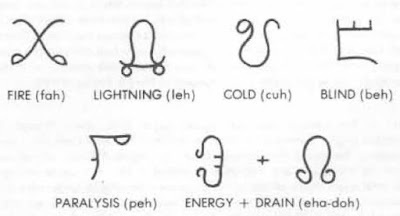 Gygax suggests that referees "design [their] own or use an encyclopedia to find interesting alphabets to use." He also suggests that the referee might look to the example of
The World of Greyhawk
for further runes and glyphs.
Gygax suggests that referees "design [their] own or use an encyclopedia to find interesting alphabets to use." He also suggests that the referee might look to the example of
The World of Greyhawk
for further runes and glyphs. On the next page, while discussing the cleric spell aerial servant, Gygax briefly notes that "the spell caster should be required to show you the form of protective inscription he or she has used when the spell is cast." He then provides illustrations for the three forms mentioned by name in the spell's description in the Players Handbook.
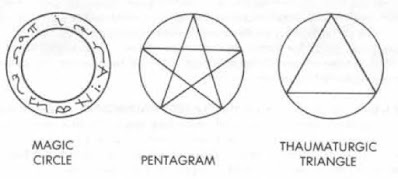 In looking at these two sections, I was reminded that, while AD&D has this reputation in some quarters as being very precise and even nitpicky, especially compared with OD&D, there's still a great deal that's left to the individual referee to resolve. In the case of the glyph of warding, for example, its effect is variable to some degree, with just how some of possibilities (i.e. paralysis, blindness, and energy drain) function left unclear. Similarly, there's no clear mechanical difference, if any is intended, between the three illustrated types of protective inscriptions. It's another one of those things the referee is left to decide for himself.
In looking at these two sections, I was reminded that, while AD&D has this reputation in some quarters as being very precise and even nitpicky, especially compared with OD&D, there's still a great deal that's left to the individual referee to resolve. In the case of the glyph of warding, for example, its effect is variable to some degree, with just how some of possibilities (i.e. paralysis, blindness, and energy drain) function left unclear. Similarly, there's no clear mechanical difference, if any is intended, between the three illustrated types of protective inscriptions. It's another one of those things the referee is left to decide for himself. Frankly, I see this as a strength in AD&D and indeed any roleplaying game. I have little interest in a RPG that leaves no "creative lacunae" where the referee can exercise his own imagination. Moreover, any game that did attempt to cover every base would necessarily be immense in scope, not to mention length. I'd much rather spend my time playing – and making things up – than seeking out every jot and tittle of the rules. I doubt I'm unique in this regard.
December 28, 2022
Grognard's Grimoire: Omejaldalu (Unmaker)
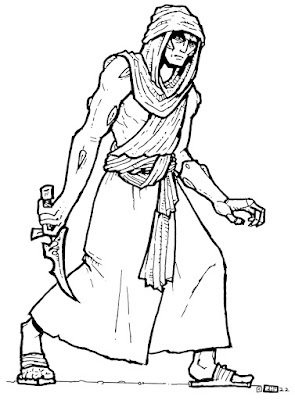 An Unmaker initiate by Zhu BajieThe Omejaldalu, or Unmakers, are a loose collection of cults whose leaders see the Makers as having been detached, corrupt, and, above all, stifling to the development of sha-Arthan and its inhabitants. The Unmakers, therefore, seek to free the world from the shackles imposed by the Makers by using both sorcery and science to tear down and destroy every established norm, pattern, or system, including those of reality itself. In so doing, the Unmakers hope to inaugurate an era of unparalleled liberty – or another Epoch of Strife.
An Unmaker initiate by Zhu BajieThe Omejaldalu, or Unmakers, are a loose collection of cults whose leaders see the Makers as having been detached, corrupt, and, above all, stifling to the development of sha-Arthan and its inhabitants. The Unmakers, therefore, seek to free the world from the shackles imposed by the Makers by using both sorcery and science to tear down and destroy every established norm, pattern, or system, including those of reality itself. In so doing, the Unmakers hope to inaugurate an era of unparalleled liberty – or another Epoch of Strife.(More information about the Unmakers can be found here)
Initiate
Wholly devoted to the Unmaker cult to which he belongs, an initiate hopes his loyalty will one day be rewarded with greater responsibilities – and the power that comes with it.
DR 12, HD 2* (9hp), Att 1 × weapon (1d6 or by weapon), AB +0, MV Near, SV F11 D12 M13 E16 S15 (A2), ML 9 (11 with prophet), XP 25, NA 1d8 (2d12), TT U
• Unmaker’s Blessing: Each initiate has 10% chance to have received an alchemical boon that increases his DR (1–2), HD (3–4), AB (5–6), or damage (7–8) by +2 (roll 1d8).
• Zealous: +2 to saves against spells or effects intended to negatively affect an initiate’s loyalty to his cult.
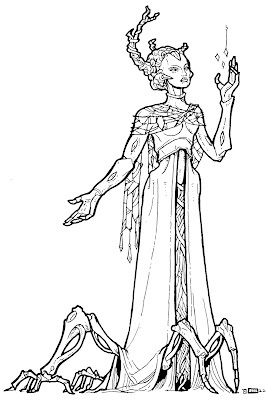 An Unmaker prophet by Zhu Bajie
An Unmaker prophet by Zhu BajieProphet
The leader of a cult, a prophet is a living embodiment of the Unmaker philosophy – nihilism and material transcendence made manifest. Each prophet is unique in his particular approach to the Unmakers’ doctrines, as well as in his appearance and powers.
DR 16, HD 9*** (40hp), Att 1 × weapon (1d4 or by weapon) or 1 × spell, AB +7, MV Near, SV F8 D9 M10 E10 S12 (A2), ML 10, XP 3000, NA 1 (1), TT F
• Magic Resistance: Unaffected by mind-affecting or mind-reading spells.
• Spells: Each prophet casts spells as if he were a 9th-level sorcerer.
• Material Transcendence: A prophet has 1d3 modifications to his body, determined randomly (1d8), re-roll duplicates. Referee is encouraged to create additional modifications.
1. Displacement: Appears in different place from actual location; attacker suffers –2 to hit.
2. Energy Immunity: Unharmed by cold or electrical attacks.
3. Hardened Flesh: All attacks do –1 damage per die.
4. Heightened Awareness: Never surprised.
5. Heightened Reflexes: +2 initiative.
6. Heightened Strength: +2 melee damage.
7. Regeneration: Regain 2hp per round until slain.
8. Telepathy: As the adept discipline of the same name. Treated prophet as adept of same level as HD.
Grognard's Grimoire: Omejdalu (Unmaker)
 An Unmaker initiate by Zhu BajieThe Omejaldalu, or Unmakers, are a loose collection of cults whose leaders see the Makers as having been detached, corrupt, and, above all, stifling to the development of sha-Arthan and its inhabitants. The Unmakers, therefore, seek to free the world from the shackles imposed by the Makers by using both sorcery and science to tear down and destroy every established norm, pattern, or system, including those of reality itself. In so doing, the Unmakers hope to inaugurate an era of unparalleled liberty – or another Epoch of Strife.
An Unmaker initiate by Zhu BajieThe Omejaldalu, or Unmakers, are a loose collection of cults whose leaders see the Makers as having been detached, corrupt, and, above all, stifling to the development of sha-Arthan and its inhabitants. The Unmakers, therefore, seek to free the world from the shackles imposed by the Makers by using both sorcery and science to tear down and destroy every established norm, pattern, or system, including those of reality itself. In so doing, the Unmakers hope to inaugurate an era of unparalleled liberty – or another Epoch of Strife.(More information about the Unmakers can be found here)
Initiate
Wholly devoted to the Unmaker cult to which he belongs, an initiate hopes his loyalty will one day be rewarded with greater responsibilities – and the power that comes with it.
DR 12, HD 2* (9hp), Att 1 × weapon (1d6 or by weapon), AB +0, MV Near, SV F11 D12 M13 E16 S15 (A2), ML 9 (11 with prophet), XP 25, NA 1d8 (2d12), TT U
• Unmaker’s Blessing: Each initiate has 10% chance to have received an alchemical boon that increases his DR (1–2), HD (3–4), AB (5–6), or damage (7–8) by +2 (roll 1d8).
• Zealous: +2 to saves against spells or effects intended to negatively affect an initiate’s loyalty to his cult.
 An Unmaker prophet by Zhu Bajie
An Unmaker prophet by Zhu BajieProphet
The leader of a cult, a prophet is a living embodiment of the Unmaker philosophy – nihilism and material transcendence made manifest. Each prophet is unique in his particular approach to the Unmakers’ doctrines, as well as in his appearance and powers.
DR 16, HD 9*** (40hp), Att 1 × weapon (1d4 or by weapon) or 1 × spell, AB +7, MV Near, SV F8 D9 M10 E10 S12 (A2), ML 10, XP 3000, NA 1 (1), TT F
• Magic Resistance: Unaffected by mind-affecting or mind-reading spells.
• Spells: Each prophet casts spells as if he were a 9th-level sorcerer.
• Material Transcendence: A prophet has 1d3 modifications to his body, determined randomly (1d8), re-roll duplicates. Referee is encouraged to create additional modifications.
1. Displacement: Appears in different place from actual location; attacker suffers –2 to hit.
2. Energy Immunity: Unharmed by cold or electrical attacks.
3. Hardened Flesh: All attacks do –1 damage per die.
4. Heightened Awareness: Never surprised.
5. Heightened Reflexes: +2 initiative.
6. Heightened Strength: +2 melee damage.
7. Regeneration: Regain 2hp per round until slain.
8. Telepathy: As the adept discipline of the same name. Treated prophet as adept of same level as HD.
December 27, 2022
Retrospective: The Necromican
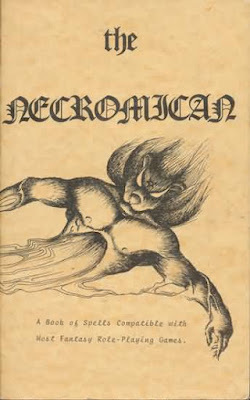 Last week, I took a look at Booty and the Beasts, an unofficial bestiary for use with Dungeons & Dragons and other fantasy roleplaying games published in 1979. The book is worthy of examination not just for its idiosyncratic content but also for its creators, the most notable of whom are Paul Reiche III and Erol Otus, both of whom would go on to work at TSR during the final years of D&D's Golden Age.
Last week, I took a look at Booty and the Beasts, an unofficial bestiary for use with Dungeons & Dragons and other fantasy roleplaying games published in 1979. The book is worthy of examination not just for its idiosyncratic content but also for its creators, the most notable of whom are Paul Reiche III and Erol Otus, both of whom would go on to work at TSR during the final years of D&D's Golden Age.
Booty and the Beasts is thus a significant historical artifact of the early days of the hobby. However, it was not the only product of the partnership of Reiche and Otus (and Mathias Genser, who does not appear to have any RPG credits beyond these two collaborations). The same year, they also published The Necromican, "a book of spells compatible with most fantasy role-playing games." As with their other effort, "most fantasy role-playing games" very likely meant Dungeons & Dragons, though, in fairness, the spell descriptions are sufficiently loose that they could be used for any FRPG that makes use of spell levels, such as Tunnels & Trolls or Arduin (itself in a rather complex position with regards to its relationship to D&D). The fact that the spells presented in The Necromican range up to level 12 suggests that the authors may well have had an expansive notion of the book's potential audience.
This is what the book's forward [sic] states about its purpose:
This book of spells is not intended to stand by itself, or replace other fantasy role playing game spell lists. Rather, it is intended to supplement the many spell lists in existence, and provide a greater variety and selection for the players. It does not offer an alternate spell system; rather, the spells should be adapted into whatever spell system you prefer. The levels given for the spells are based on our own playing experience, however, it is the privilege of the individual games masters to change the level of any spell so that it will better fit into their own universes.
This is very much in the spirit of reckless invention and experimentation that permeated the early days of the hobby. Unless you're Gary Gygax on one of his bad days, I find it impossible to understand how one could object to a single word written above. In many ways, it's the part of The Necromican I find most inspiring.
The book contains over 130 spells, divided, as I noted, into twelve levels. They range widely in utility – and seriousness. Thus, you find spells like primal premonition, which causes the hairs on the neck of the caster to rise one melee round in advance of danger, or immolation, which causes the caster to burst into flames that are harmless to him but that do damage to anyone who touches him for the duration of the spell. At the same time, there are spells like spell of good groomng, which "will act as a shower, haircut, and laundry for those affected," or color alteration, which "allows the caster to change his skim color." These are in addition to several spells obviously derived from the works of Jack Vance, such as the spell of forlorn encystment and the excellent prismatic spray.
Like Booty and the Beasts, The Necromican also skirts the edges between fantasy and science fiction with some of its spells. For example, there is the 12th-level spell the sorcerer's spacecraft, which, as its name suggests, conjures a flying saucer that "travels at 10,000,000 miles per hour," enabling transit to Mars as part of a "pleasant afternoon flight." How one takes this, I suppose, depends on the extent to which you enjoy chocolate in your peanut butter, but there is no question that, at the time, it was not at all unusual. If anything, the popular conception of "fantasy" has ossified a great deal since 1979. The Necromican reflects this more "porous" understanding of the genre and is, therefore, a useful corrective to those of us with more straitened horizons.
That said, I'm honestly not certain I'd make use of almost any of the new spells presented here. A great many of them are useful only in very specific circumstances, while others are "game-y" in conception (e.g. competent cartography, which prevents the caster from making a mistake in his mapmaking). Others are simply so idiosyncratic that they likely reflect the circumstances of the writers' own campaigns, such as the benign boots, which transports the caster's corpse back to a safe locale via the Astral Plane. Now, I genuinely appreciate such idiosyncrasy. Indeed, I am a strong advocate for referees and players making their campaigns downright odd and impenetrable to outsiders, but, of course, doing so gets in the way of selling to lots of copies of your latest book, which may explain why we don't see efforts like The Necromican much anymore – a pity!
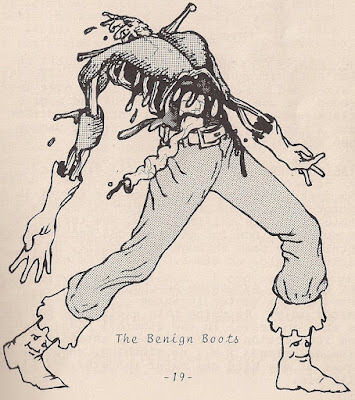 Behold! The benign boots in action.
Behold! The benign boots in action.
December 25, 2022
Yule Horror
There is snow on the ground,
And the valleys are cold,
And a midnight profound
Blackly squats o’er the wold;
But a light on the hilltops half-seen hints of feastings unhallow’d and old.
There is death in the clouds,
There is fear in the night,
For the dead in their shrouds
Hail the sun’s turning flight,
And chant wild in the woods as they dance round a Yule-altar fungous and white.
To no gale of earth’s kind
Sways the forest of oak,
Where the sick boughs entwin’d
By mad mistletoes choke,
For these pow’rs are the pow’rs of the dark, from the graves of the lost Druid-folk.
And mayst thou to such deeds
Be an abbot and priest,
Singing cannibal greeds
At each devil-wrought feast,
And to all the incredulous world shewing dimly the sign of the beast.
–H.P. Lovecraft,Weird Tales, December 1926
December 23, 2022
The Definitive Edition
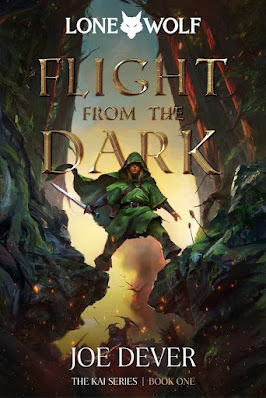 Toward the end of the summer of this year, I wrote a retrospective on Joe Dever's Lone Wolf series. The series began in 1984 and eventually grew to encompass 29 volumes before the death of Dever in 2016. Dever's son, Ben, intended to use his father's note to bring things to a conclusion (and the total number of books to 32).
Toward the end of the summer of this year, I wrote a retrospective on Joe Dever's Lone Wolf series. The series began in 1984 and eventually grew to encompass 29 volumes before the death of Dever in 2016. Dever's son, Ben, intended to use his father's note to bring things to a conclusion (and the total number of books to 32).To do that, Holmgard Press has announced the Definitive Edition of Lone Wolf in the United Kingdom. This edition consists of hardcover books with all new cover and interior illustrations, along with several other improvements and embellishments. There's no word yet as to when (or if) this edition will be released anywhere else in the world, though I hope it will be, since there's a lot of interest in this series outside the UK.
You can find out more about the Definitive Edition and other Lone Wolf-related news at its official website.
December 22, 2022
Dungeon23
Megadungeon for 2023. 12 levels. 365 rooms. One room a day. Keep it all in a journal. @LukeGearing let’s do this. pic.twitter.com/tCVgh8i1MF
— 💭 Sean McCoy (@seanmccoy) December 5, 2022
An old mantra of this blog has long been that "roleplaying games were born in the megadungeon." By this, I simply mean that most of the earliest examples of what we would today recognize as RPGs were played in the context of exploring an immense, subterranean locale filled with monsters, magic, and mysteries – Dungeons & Dragons, Tunnels & Trolls, and Empire of the Petal Throne, to cite just three examples, all assume that much of a campaign's action will center around delving into the depths. Obviously, roleplaying games can (and should) include so many more activities, but there's something satisfyingly primal about braving the mythic underworld and returning to tell the tale.
To be worthy of the name, a megadungeon shouldn't merely be vast in size, it should also contain enough to hold the players' attentions for a long period of time. Unlike smaller, more focused "lair" dungeons, like those typically found in published adventure modules, a megadungeon is a sprawling, rambling thing that isn't about any one thing, nor is it possible to "clear" it. Instead, it's a place to which the characters can come again and again over the course of weeks, months, or even years without ever fully exhausting. A megadungeon can thus be the centerpiece of a campaign, in the way that Castles Blackmoor and Greyhawk were in their respective campaigns and the Jakállan Underworld was in the earliest Tékumel campaign.
I was reminded of all of this for two unrelated reasons. First, as you'll know, I've been working on a science fantasy RPG I'm calling The Secrets of sha-Arthan. When I first conceived of the idea a year and a half ago, I called the project The Vaults of sha-Arthan. The Vaults of the title are megadungeons by another name – deep, ancient labyrinths reputed to contain the secrets of the deific Makers. From the beginning, I knew I wanted to develop one of these Vaults as the basis of a sha-Arthan campaign and have been slowly poking at the idea ever since.
Second, Sean McCoy, the creator of Mothership, proposed something that's come to be known as Dungeon23. The idea quite simple: create one room each day for a megadungeon throughout the entirety of 2023 and then share the results. I thought this was a great idea, if only because it took what might otherwise have seemed like an insurmountable endeavor and broke it down into a much more manageable form. Since I was already contemplating the development of one of the Vaults of sha-Arthan for use in a campaign, Sean's idea struck me as worthy of an attempt.
So, among other things, 2023 will see me attempt to flesh out the Vaults beneath the ancient city of da-Imer one room at a time. Since I already have a lot of ideas of what that fabled underworld might contain, I'm pretty confident that I'll be able to keep up the pace for a while. Of course, this is a marathon, not a sprint. The real test comes after a few weeks or even months, after the novelty of the exercise begins to wear off and the realization that a year is a long time to commit to a single project.
I'll have a few more thoughts on this over the next week or so, as I prepare to get started. For now, I only wanted to say publicly that I intend to pick up the gauntlet Sean has thrown on the ground. Wish me luck.
December 21, 2022
The Unspeakable
I've never been very fond of Deities & Demigods, though, being a TSR fanboy, I nevertheless dutifully purchased it. In my youth, the DDG sat on my bookshelf largely untouched, which is why my copy of it looks practically pristine to this day, in stark contrast to my copies of the Players Handbook, the Dungeon Masters Guide, and – especially – the Monster Manual.
Even so, I'd occasionally flip through its pages and read random sections to see what little bits of esoterica I might find. I strongly remember the first time I noticed the following statement at the end of James Ward's preface:
Special thanks are also given to Chaosium, Inc. for permission to use the material found in the Cthulhu Mythos and the Melnibonean Mythos.
This baffled me, since there are no references to either the creations of Lovecraft or Moorcock in Deities & Demigods. What could this possibly mean? Sometime later, I learned from one of the older gamers whom I knew that there'd been some sort of "legal dispute" between TSR and Chaosium, resulting in the removal of chapters on the Cthulhu and Melnibonean mythoi from the DDG. As you might imagine, this revelation filled me with excitement, though it wouldn't be until I was in college that I'd ever set my eyes on these expurgated chapters.
Thanks to a very kind friend, I now own a copy of the original printing of Deities & Demigods, which has probably seen more reading than my original one, largely because of the two chapters TSR removed. I suspect I've spent more time reading the Cthulhu Mythos chapter than the Melnibonean Mythos chapter and a big reason why is its downright funky art by Erol Otus.
All of the art in this chapter is awesome, but the piece that really sticks with me is this one:
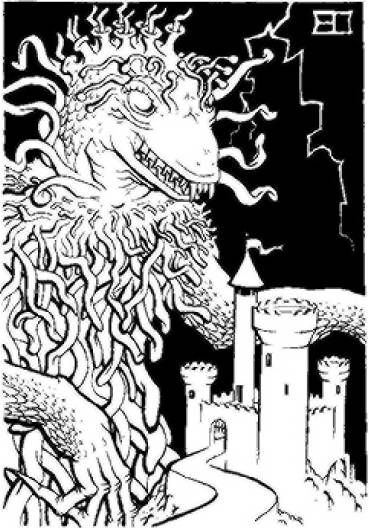 Supposedly, this depicts Hastur the Unspeakable, who is little more than a name in Lovecraft's works but was a favorite of August Derleth, who decided that Hastur was Cthulhu's "half-brother," whatever that means. The DDG entry describes Hastur as having "a scaled, elongated body, a lizard's head and maw, and taloned lizard claws. It also has 200 tentacles projecting from its body ..." I have no idea where this description comes from, since not even Derleth bothered to describe his favorite Great Old One as far as I can recall.
Supposedly, this depicts Hastur the Unspeakable, who is little more than a name in Lovecraft's works but was a favorite of August Derleth, who decided that Hastur was Cthulhu's "half-brother," whatever that means. The DDG entry describes Hastur as having "a scaled, elongated body, a lizard's head and maw, and taloned lizard claws. It also has 200 tentacles projecting from its body ..." I have no idea where this description comes from, since not even Derleth bothered to describe his favorite Great Old One as far as I can recall.Regardless, there's no question it's a very striking image. I particularly like the juxtaposition of a fairly ordinary looking medieval castle with this bizarre monstrosity. I've sometimes thought it might be interesting to referee a medieval Call of Cthulhu campaign, perhaps taking inspiration from Clark Ashton Smith's Averoigne series, but I've never pursued the matter seriously. If I ever do, you can be sure I'll take inspiration from this piece by Erol Otus.
James Maliszewski's Blog
- James Maliszewski's profile
- 3 followers




